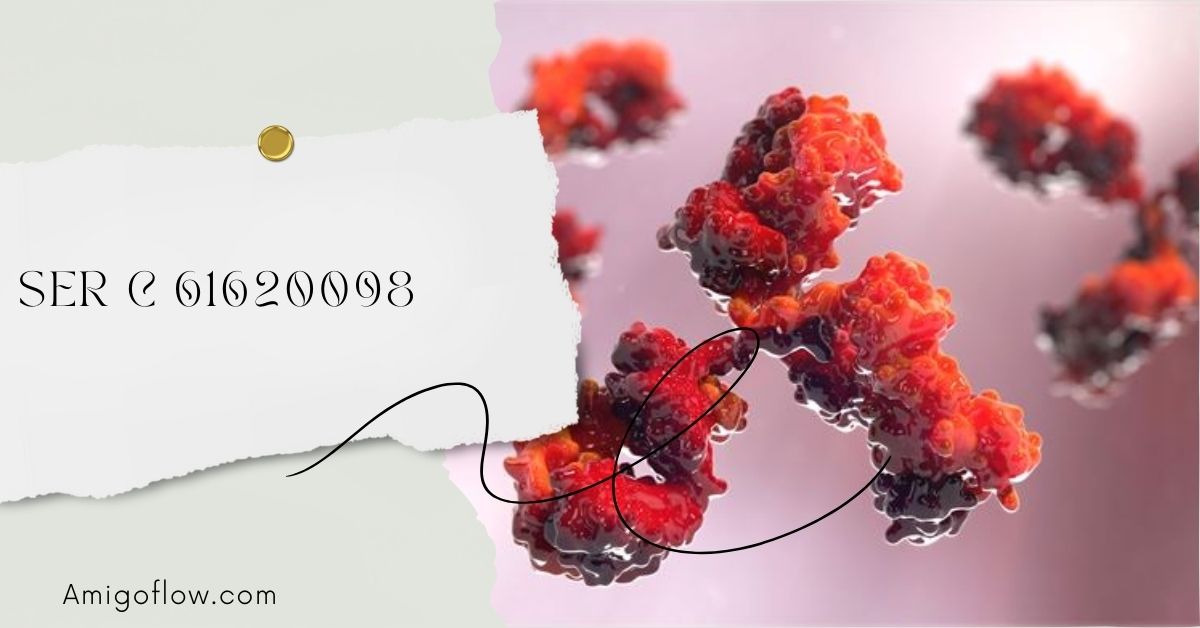In the world of scientific research, specialized codes or reference numbers are often assigned to chemical compounds, pharmaceuticals, or other substances used for research and medical purposes.
One such reference number is SER C 61620098, which might correspond to a specific chemical compound or pharmaceutical product. While there is limited public information regarding this exact code, understanding its potential uses based on similar research substances offers valuable insight into its significance.
In this article, we’ll dive deep into SER C 61620098, explore its potential uses, applications, and benefits, and provide a humanized explanation of why such substances are important in medical and scientific research.
What is SER C 61620098?
SER C 61620098 is a reference number that may be linked to a specific chemical compound, pharmaceutical substance, or other research materials. While exact public details on this substance are sparse, we can infer from similar compounds that it could be used in fields such as medical research, pharmaceutical development, or biotechnology.
In scientific studies, researchers often work with unique compounds that are assigned identifiers like SER C 61620098 to streamline their studies. These identifiers make it easier to track, reference, and utilize substances in experiments, clinical trials, and even the production of medical treatments.
Key Characteristics of SER C 61620098:
- Type: Research or medical compound (hypothetical assumption based on similar codes)
- Applications: Medical research, scientific studies, pharmaceutical development
- Potential Fields: Medicine, biology, chemistry, pharmacology
Possible Uses of SER C 61620098 in Research
Substances like SER C 61620098 are often vital to scientific research, where they are tested for their effects, reactions, and potential benefits in various scenarios. Below are a few hypothetical uses of SER C 61620098 based on common applications of similar research compounds:
a. Drug Development
One of the most critical aspects of medical research is the development of new medications. A compound such as SER C 61620098 might be studied for its pharmacological properties to assess whether it could be a potential drug candidate. Researchers would look at:
- Its chemical structure
- Potential interactions with biological targets
- Effectiveness in treating specific medical conditions
b. Biological Research
SER C 61620098 could be used in biological studies to understand how it interacts with cells, tissues, or organs. Biological research often focuses on how certain chemicals impact the human body, allowing scientists to uncover insights about diseases, cellular functions, and overall human biology.
c. Toxicology Testing
Before any new drug or chemical compound can be approved for use, it undergoes rigorous toxicology tests to ensure its safety. SER C 61620098 could be evaluated in controlled environments to study potential toxic effects at various doses.
d. Mechanism of Action Studies
Compounds like SER C 61620098 may be explored for their mechanism of action. This means researchers would study how it works at a molecular level, what processes it influences, and how it may lead to beneficial or harmful effects in biological systems.
Applications in Medicine and Pharmaceuticals
The development of new pharmaceuticals is a time-consuming and expensive process, but compounds like SER C 61620098 could play a crucial role in advancing the field. Based on its chemical profile, which remains hypothetical, it could serve multiple roles in the medical and pharmaceutical industries:
a. Therapeutic Agents
If SER C 61620098 demonstrates potential as a therapeutic agent, it might be used to develop drugs that can treat specific illnesses. Researchers look for chemical compounds that can:
- Target specific diseases
- Treat conditions by interacting with biological systems
- Improve patient outcomes in chronic or acute conditions
b. Antibiotics or Antivirals
There is a continuous need to discover new antibiotics or antiviral agents due to the rise of drug-resistant strains of bacteria and viruses. If SER C 61620098 shows promise in combating infections, it could be developed as a new treatment in these fields.
c. Treatment of Chronic Diseases
Many research compounds are examined for their ability to treat chronic diseases such as diabetes, hypertension, and neurological disorders. If SER C 61620098 affects certain biological pathways, it could potentially be effective in managing these types of conditions.
d. Oncology (Cancer Treatment)
One of the most urgent areas of pharmaceutical research is oncology. Compounds that show potential in killing cancer cells, halting tumor growth, or boosting the immune system’s ability to fight cancer could have life-saving implications. SER C 61620098 may be studied for such properties, especially if its chemical structure suggests anticancer activity.
Potential Benefits of SER C 61620098
Although detailed information about SER C 61620098 remains speculative, we can analyze potential benefits based on its hypothetical applications.
a. Advancing Medical Knowledge
Compounds like SER C 61620098 help researchers learn more about the human body and diseases, leading to significant advancements in our understanding of medical conditions and how to treat them.
b. Innovative Treatments
If SER C 61620098 exhibits promising results in studies, it may lead to the development of innovative treatments for diseases that currently have limited or no effective therapies.
c. Improved Drug Efficacy
By testing new compounds, researchers can discover medications with higher efficacy, fewer side effects, and more targeted approaches to treatment, ultimately improving patient care.
d. Enhancing Safety in Medications
Thorough toxicology testing on compounds like SER C 61620098 ensures that only safe, effective medications reach the market. This protects patients from harmful side effects while maximizing the therapeutic benefits of new drugs.
Safety, Testing, and Regulations
The safety of research compounds like SER C 61620098 is a top priority in the scientific community. Before any compound can be used in the general population, it undergoes extensive safety testing. Here’s a breakdown of the safety protocols that may apply to SER C 61620098:
a. Preclinical Trials
Initial studies, often referred to as preclinical trials, are conducted in a laboratory setting or using animal models. These trials help researchers determine if a compound is safe enough to move to human trials.
b. Clinical Trials (Phases 1-3)
- Phase 1: In this phase, the compound is tested on a small group of healthy individuals to assess its safety.
- Phase 2: A larger group of patients is treated to evaluate efficacy and further examine safety.
- Phase 3: Extensive testing is conducted on a large population to confirm its effectiveness, monitor side effects, and compare it to existing treatments.
c. Regulatory Approval
Once a compound has passed clinical trials, regulatory agencies like the U.S. Food and Drug Administration (FDA) review the data to decide whether it can be approved for medical use. The same process might apply to SER C 61620098 if it is developed into a medication.
d. Post-Marketing Surveillance
After approval, the safety of the compound continues to be monitored through post-marketing surveillance to identify any long-term effects or rare side effects that may not have been apparent in clinical trials.
How Does SER C 61620098 Compare to Other Research Compounds?
In research settings, SER C 61620098 would likely be compared to other chemical compounds that have similar structures or functions. These comparisons help researchers determine its uniqueness, effectiveness, and safety.
a. Novelty
If SER C 61620098 has a unique chemical structure, it may offer new mechanisms of action that are not seen in existing compounds, making it a valuable addition to medical research.
b. Efficiency
Researchers would compare how efficiently SER C 61620098 achieves desired effects, such as targeting specific cells or reducing symptoms, relative to other known substances.
c. Side Effects
Side effects and safety profiles are critical in determining the suitability of any compound for medical use. SER C 61620098 would be evaluated against other compounds to ensure that it offers therapeutic benefits with minimal adverse effects.
Future Implications and Research Directions
As research continues, compounds like SER C 61620098 could open doors to new medical treatments, potentially providing breakthroughs in treating diseases that currently have no cure. Hypothetically, SER C 61620098 could be part of the following future directions in research:
a. Personalized Medicine
With advancements in genetic research, SER C 61620098 could be part of personalized treatments tailored to an individual’s genetic makeup, allowing for more precise and effective therapies.
b. Advanced Drug Delivery Systems
Researchers are always looking for better ways to deliver drugs to targeted areas of the body. SER C 61620098 could play a role in developing drug delivery systems that enhance the efficiency and precision of medications.
c. Biotechnology and Gene Therapy
If SER C 61620098 demonstrates potential in modifying biological pathways, it may contribute to gene therapy research, providing treatments for genetic disorders by correcting defective genes.
FAQs About SER C 61620098
What is SER C 61620098 used for?
While specific details about SER C 61620098 are not publicly available, it may be used in scientific or medical research. Its potential applications could include drug development, biological studies, or toxicology testing.
Is SER C 61620098 safe?
The safety of SER C 61620098 would depend on thorough testing, including preclinical and clinical trials. Until such studies are completed, its safety profile remains unknown.
Can SER C 61620098 be used in humans?
Before any compound can be used in humans, it must pass stringent clinical trials and receive approval from regulatory authorities like the FDA. There is no public information available yet about whether SER C 61620098 has undergone such testing.
What are the potential benefits of SER C 61620098?
Potential benefits of SER C 61620098 could include advances in medical treatments, new drug development, and improved understanding of disease mechanisms.
Conclusion
Although the exact nature of SER C 61620098 remains speculative, we can infer from its categorization that it holds potential significance in scientific and medical research. Research compounds like SER C 61620098 are essential for advancing our understanding of biology, developing new treatments, and improving patient care.
As more information becomes available, we may gain a deeper understanding of SER C 61620098 and its applications in medicine, pharmaceuticals, and biotechnology.















